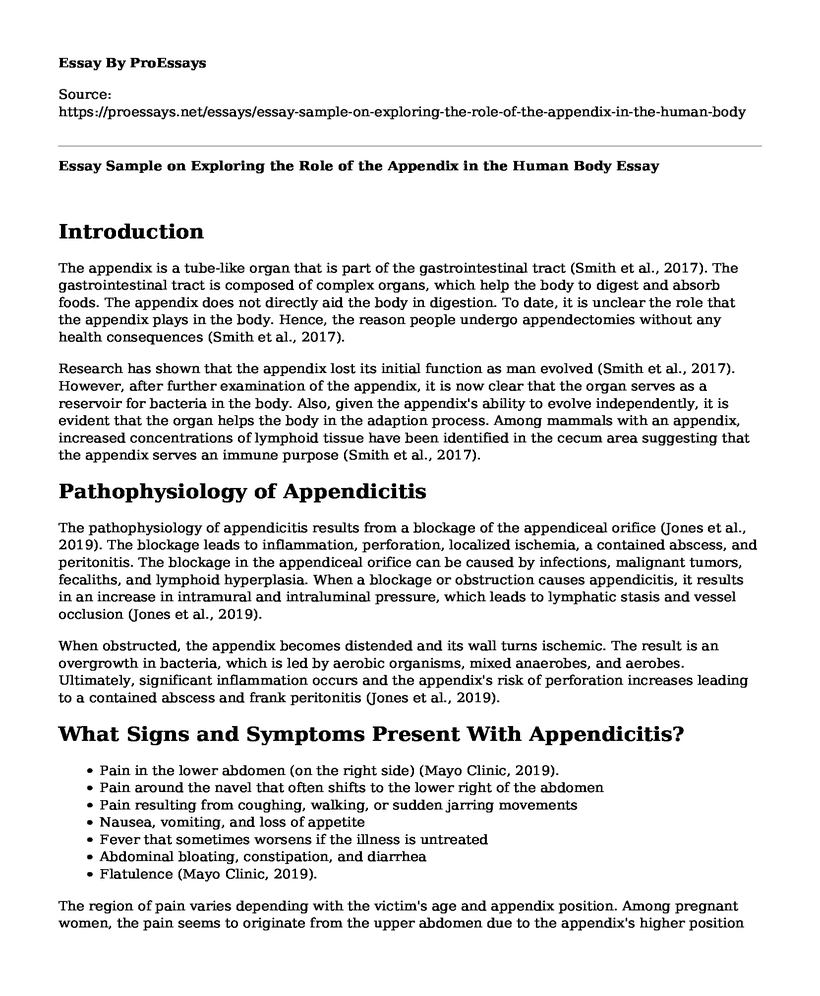Introduction
The appendix is a tube-like organ that is part of the gastrointestinal tract (Smith et al., 2017). The gastrointestinal tract is composed of complex organs, which help the body to digest and absorb foods. The appendix does not directly aid the body in digestion. To date, it is unclear the role that the appendix plays in the body. Hence, the reason people undergo appendectomies without any health consequences (Smith et al., 2017).
Research has shown that the appendix lost its initial function as man evolved (Smith et al., 2017). However, after further examination of the appendix, it is now clear that the organ serves as a reservoir for bacteria in the body. Also, given the appendix's ability to evolve independently, it is evident that the organ helps the body in the adaption process. Among mammals with an appendix, increased concentrations of lymphoid tissue have been identified in the cecum area suggesting that the appendix serves an immune purpose (Smith et al., 2017).
Pathophysiology of Appendicitis
The pathophysiology of appendicitis results from a blockage of the appendiceal orifice (Jones et al., 2019). The blockage leads to inflammation, perforation, localized ischemia, a contained abscess, and peritonitis. The blockage in the appendiceal orifice can be caused by infections, malignant tumors, fecaliths, and lymphoid hyperplasia. When a blockage or obstruction causes appendicitis, it results in an increase in intramural and intraluminal pressure, which leads to lymphatic stasis and vessel occlusion (Jones et al., 2019).
When obstructed, the appendix becomes distended and its wall turns ischemic. The result is an overgrowth in bacteria, which is led by aerobic organisms, mixed anaerobes, and aerobes. Ultimately, significant inflammation occurs and the appendix's risk of perforation increases leading to a contained abscess and frank peritonitis (Jones et al., 2019).
What Signs and Symptoms Present With Appendicitis?
- Pain in the lower abdomen (on the right side) (Mayo Clinic, 2019).
- Pain around the navel that often shifts to the lower right of the abdomen
- Pain resulting from coughing, walking, or sudden jarring movements
- Nausea, vomiting, and loss of appetite
- Fever that sometimes worsens if the illness is untreated
- Abdominal bloating, constipation, and diarrhea
- Flatulence (Mayo Clinic, 2019).
The region of pain varies depending with the victim's age and appendix position. Among pregnant women, the pain seems to originate from the upper abdomen due to the appendix's higher position during pregnancy (Mayo Clinic, 2019).
Your patient is 1st day post op appendectomy. As the student RN what care is important for your patient at this time? If NG tube is in place for this patient, please explain the purpose of NG tube at this time.
Post-Operative Care
- Ensuring the patient breathes and respires normally. I would do this by encouraging deep breaths every 2 hours, giving the patient a spirometer, and changing his or her patient every 2 hours (Vera, 2019).
- Preventing phlebothrombosis and thrombophlebitis. I would do this by covering the patient in elastic bandage, and changing the covering every eight hours.
- Providing adequate nutrition and fluids. I would place a saturated gauze on the patients lips and give him or her food when peristalsis begins.
- Preventing hyperthermia by preheating the patient's surrounding environment, covering him or her with blankets, giving warm perfusions.
- Ensuring the patient gets enough sleep by eliminating noise, anxiety, strong lighting, and noise (Vera, 2019).
The NG tube would be in place for my patient to help with acute dilatation of the stomach. Dilatation of the stomach occurs when fluids accumulate in the stomach but cannot pass through the gastro-duodenal sphincter. To prevent such complication, the NG tube would be put in place and taken off when peristalsis starts (Vera, 2019).
References
Jones, M. W., Lopez, R. A., & Deppen, J. G. (2019, December 8). Appendicitis. NCBI. https://www.ncbi.nlm.nih.gov/books/NBK493193/
Mayo Clinic. (2019, May 24). Appendicitis, symptoms & causes: Overview. Mayo Clinic. https://www.mayoclinic.org/diseases-conditions/appendicitis/symptoms-causes/syc-20369543
Smith, H. F., Parker, W., Kotze, S. H., & Laurin, M. (2017). Morphological evolution of the mammalian cecum and cecal appendix. Comptes Rendus Palevol, 16(1), 39-57. https://doi.org/10.1016/j.crpv.2016.06.001
Vera, M. (2019, April 10). 4 appendectomy nursing care plans. Nurselabs. https://nurseslabs.com/4-appendectomy-nursing-care-plans/
Cite this page
Essay Sample on Exploring the Role of the Appendix in the Human Body. (2023, May 22). Retrieved from https://proessays.net/essays/essay-sample-on-exploring-the-role-of-the-appendix-in-the-human-body
If you are the original author of this essay and no longer wish to have it published on the ProEssays website, please click below to request its removal:
- Essay Example on Human Cloning
- How Does Bioethics Affect the Development of Stem Cell Research?
- Animal and Ethics Essay Example
- Essay Sample on Dairy Farming Facilities and Staffing
- Essay Sample on Understanding the Crucial Role of the Elbow Joint in the Upper Extremity
- White River Forest: A National Reserve Since the Late Eighties - Research Paper
- Essay Example on the Next Decade: Human Augmentation & Global Challenges







